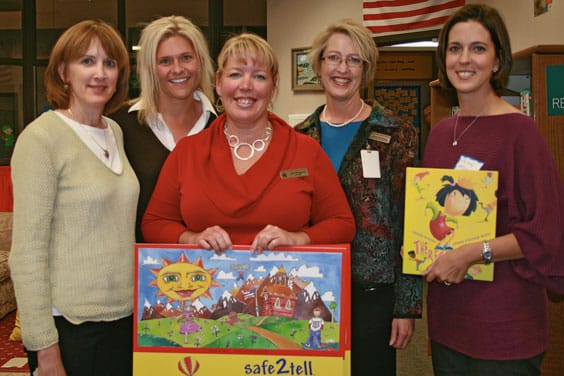Buffalo Ridge Education Alliance tackles bullying head-on

Bullyproofing BRE (from left to right): Lynn Bisesi, Jen Jacoway, Ally Berggren, Leslie Clemensen and Christy McDonald.
Article and photo by Elean Gersack
October was National Bully Awareness Month and all across America, news media focused on tragic outcomes when bullying took its toll.
Bullying grows as children grow, so what may start as verbal taunting, isolation or aggression can turn much more serious over time. With the age of the Internet, bullying can go viral in seconds, too. Now m
ore than ever, it is important to face this problem head-on and do so when kids are young.
In October, the Buffalo Ridge Educational Alliance (BREA) hosted a Bullying Roundtable for parents. Christy McDonald, parent and BREA member, organized a panel of experts to lead the dialogue: Leslie Clemensen, student wellness coordinator for Douglas County School District; Ally Berggren, BRE principal; and Lynn Bisesi, BRE building resource coordinator and former teacher and assistant principal. Also key players in the discussion were Jen Jacoway, BRE first grade teacher, and Shannon Herzog, BRE fourth grade teacher.
As the school’s parent champion for Character Education, McDonald wants to empower kids who are bystanders and help them become heroes in the hallways. “Anyone can be a hero,” said McDonald.
It’s important to distinguish conflict from bullying. Bisesi noted that bullying is one-sided, purposeful and has no remorse. On the other hand, children in normal conflict situations have equal power and show an effort to resolve the issue. There are key differences in how girls and boys bully. Clemensen discussed how boys tend to be more aggressive and physical whereas girls tend to be more relational by starting rumors and leaving others out.
Principal Berggren was quick to point out that BRE has limited bullying issues. However, one issue is one too many. Berggren believes that behavior stems from a reason and that everyone has a story. “We have to find out why and help educate and counsel the bully into changing behaviors from negative to positive. We also need to empower students to advocate for themselves and others and to stand up to bullies,” said Berggren.
Sitting on Berggren’s desk is, “Bully-Proofing Your School: A Comprehensive Guide for Elementary Schools.” Teachers, too, are equipped with this book and are incorporating the program into classrooms. Teachers Jolie Pinke and Shannon Herzog have anti-bullying sessions with fourth-graders each Friday. “We are teaching kids to communicate better. Sitting down and talking about it can be really scary,” said Herzog.
Putting a halt on bullying behavior before it takes off is paramount. “Situations can get blown out of proportion quickly and we [adults] need to give kids tools and confidence to communicate through the problem,” said Jacoway. She also stressed the need to stay open minded. “Kids get pin-pointed at a young age. Instead of avoiding, we need to welcome people who may not fit into our norm.”
Learn more about bullying behavior and prevention from the National Center for Bullying Prevention at www.pacer.org/bullying; the Safe2Tell organization at http://safe2tell.org; or from Douglas County Sheriff Youth Education and Safety in Schools (Y.E.S.S.) at
www.dcsheriff.net/Youth_Education_and_Safety_in_Schools.html.